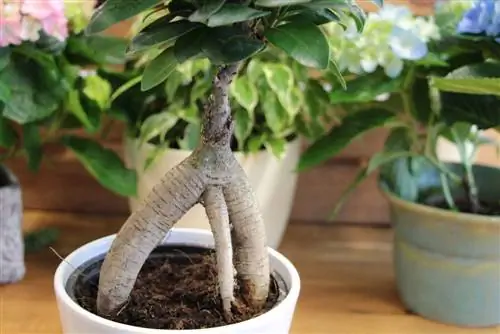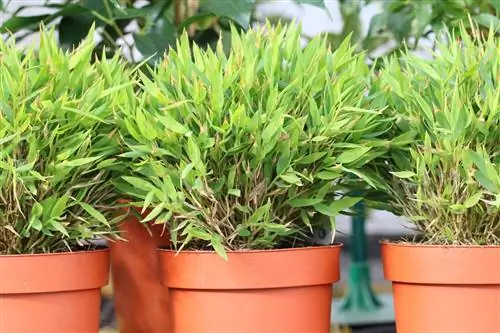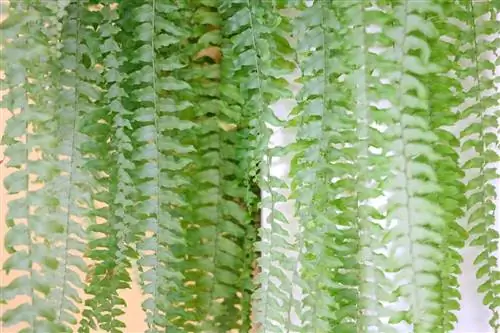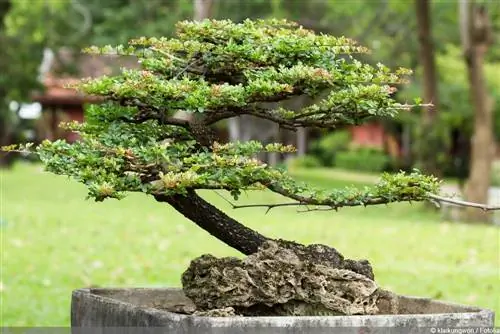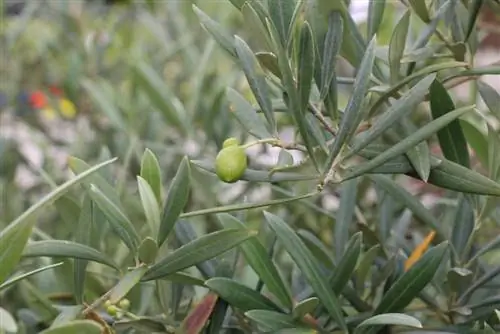- Author admin [email protected].
- Public 2023-12-17 03:39.
- Last modified 2025-01-24 12:45.
The cultivation of bonsai plants is a very complex topic. There are many points to consider, from purchase to design to the right location. Caring for an indoor bonsai is in some ways very different from cultivating other indoor plants. And a hobby gardener will not be able to avoid acquiring a certain basic knowledge. Very few types of bonsai are suitable for year-round indoor cultivation. That's why it's important to first choose a tree species that can be grown indoors all year round.
Differentiate by climate zone
One of the biggest misconceptions is the misconception that all types of bonsai can be kept indoors. In fact, for most trees it is necessary to cultivate them outdoors. They have the same requirements as their larger relatives and must be exposed to the natural course of the seasons, otherwise they will not survive. Depending on the home, a tree is more or less suitable as an indoor bonsai:
Temperate climate
Trees from temperate climate zones have winter dormancy programmed into their growth cycle. In order to be able to grow he althily over the long term, this vegetation break is one of the most important prerequisites. This cycle is severely disrupted when a deciduous tree is cultivated indoors. That's why these so-called outdoor bonsais are not suitable for indoor cultivation.
Mediterranean plants
These include trees that come from Mediterranean regions and have to spend the winter indoors because of their lack of frost hardiness, such as the olive tree. A year-round culture indoors damages the plants. You definitely need to go outside at suitable temperatures from spring to autumn. In addition, a rather cool winter period with sufficient lighting conditions is necessary in order to reproduce the plant's natural habitat.
Tropics and subtropics
Only bonsai plants that come from tropical or subtropical areas, where temperatures are constant and relatively high all year round, grow and thrive in our rooms in the long term. But a so-called indoor bonsai also likes to be placed in a protected place outdoors in summer. Pure indoor bonsai species are also known as warm house or room bonsai.
Suitable tree species
The selection of trees and shrubs that are suitable for growing a bonsai indoors is not particularly large. The following trees are easy-care indoor bonsai species that can tolerate one or two care errors:
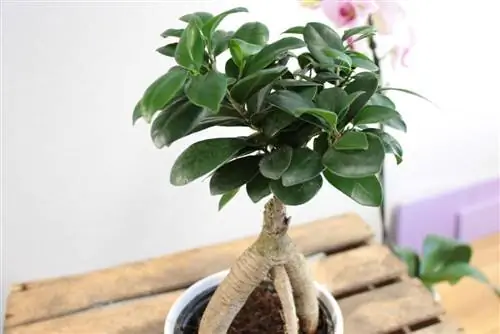
Fig tree (Ficus)
The genus Ficus belongs to the mulberry family (Moraceae), of which between 800 and 2000 species occur in all tropical regions of the world. The tropical fig trees are evergreen trees, shrubs or climbing plants. Some species also produce pretty flowers. The white milky sap that emerges from the wounds is characteristic of all types of figs. Their trunk is usually gray in color and has smooth bark. But there are also some species, such as the Ficus microcarpa Tigerbark, which has a particularly beautiful bark pattern. The trees must be placed out of the reach of pets as the ficus is poisonous to them.
- Location: as bright as possible, even full sun (also outside in summer)
- Temperature: Constantly warm, permanently above 15 degrees (does not tolerate frost)
- Humidity: Can also tolerate dry air, with high humidity forming aerial roots
- Soil: normal bonsai substrate
- Watering: water generously when the soil has become dry (low-lime, room temperature water)
- Fertilizing: solid or liquid universal fertilizer, every two weeks in summer
- Pruning: regularly cut back to 2 leaves per shoot (also tolerates severe cuts)
- Repotting: in spring every second to third year
Funkia tea (Carmona retusa)
Funca tea originally comes from China. With its small green leaves, the tree is one of the types of indoor bonsai we often offer. Its shiny leaves have small white dots on the upper side, the underside of the leaves is covered with fine white hairs. Small white flowers can appear on the plant throughout the year. Fertilization later produces yellowish to red berries, which are a very special decoration on this bonsai.
- Location: Lots of light, preferably in a bright window (also outdoors in summer)
- Temperature: ideally around 20 degrees all year round (not below 15 degrees)
- Humidity: high (does not tolerate dry heating air)
- Soil: permeable substrate with high water storage capacity
- Watering: keep rather moist, does not tolerate drought (do not produce waterlogging)
- Fertilize: solid, organic fertilizer according to the package leaflet from April to August (roots are sensitive to mineral liquid fertilizers)
- Cutting: tolerates pruning well, regular cuts promote branching
- Repotting: every two to three years in spring
Jade tree (Portulacaria afra)
The jade tree, also known as the bacon tree or shrub purslane, is native to Africa and grows as a fleshy small tree or shrub with a thick trunk. The evergreen, richly branched tree forms reddish branches with oval, water-storing leaves that can have red edges depending on the variety. The jade tree is a succulent and develops small white flowers when it has gone through one or two dry phases during the growing season.
- Location: sunny to full sun (also outdoors in summer)
- Temperature: evenly warm, never below 5 degrees
- Humidity: Can tolerate high and low humidity
- Soil: well-drained substrate
- Watering: Water sparingly, soil must dry thoroughly between watering
- Fertilize: once a month from spring to autumn
- Cutting: tolerates cuts well, do not use wound closure agents (risk of rot)
- Repotting: every two years in spring, then do not water for a week
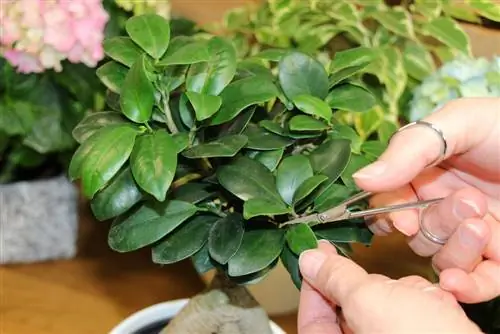
Stone yew (Podocarpus macrophyllus)
The stone yew is often found as an indoor bonsai, as the evergreen tree grows slowly and is very easy to care for. The gnarled coniferous tree resembles the yew. The foliage looks less needle-like and more flattened and long-chain. Natural occurrences of the stone yew can be found in tropical mountain regions.
- Location: bright, but protected from the midday sun, outdoor stay is advantageous in summer
- Temperature: Evenly warm in summer (around 20 degrees), slightly cooler in winter (around 15 degrees)
- Soil: permeable, slightly acidic substrate
- Watering: Keep slightly moist in summer and winter, slightly drier in cool winters
- Fertilize: every two weeks between spring and autumn, once a month if the winter is warm
- Cutting: possible all year round
- Repotting: every three years, roots must not be cut too much
Sageretia (Sageretia theezans)
Sageretie, also known as false tea, is originally native to China. With its evergreen, small leaves, it is one of the popular indoor bonsai species that can produce small white flowers in spring, from which black fruits ripen over the summer. Its bark is gray to brownish and has some light spots.
- Location: preferably morning sun, afternoon shade
- Temperature: at least 12 degrees, not frost-tolerant (preferably outdoors in summer)
- Soil: normal bonsai substrate
- Watering: must never dry out completely, check moisture daily
- Fertilize: every two weeks in spring and summer
- Cutting: Frequent cutting necessary, cut back to two leaves
- Repotting: only if the bowl is completely rooted, root pruning necessary
Pepper tree (Zanthoxylum piperitum)
If you are looking for an unusual but easy-to-care indoor bonsai, the pepper tree is the right choice. The bonsai stands out with its green pinnate leaves and exudes a sweet, peppery scent. What is also unusual about the pepper tree is its yellow wood and yellowish roots. In spring, the tree, which is native to the Himalayas, produces yellowish-white flowers that grow in groups on the shoots. The pepper tree is also available commercially as Sichuan pepper, Japanese pepper, mountain pepper or aniseed pepper.
- Location: sunny to partially shaded
- Temperature: at least 5 degrees, not frost-tolerant, possibly outdoors in summer
- Soil: permeable substrate with good water storage capacity
- Watering: high water requirement, always keep slightly moist (no waterlogging)
- Fertilize: every two weeks between April and August
- Cutting: May to September every four weeks
- Repotting: every two years in fresh substrate
Buy bonsai
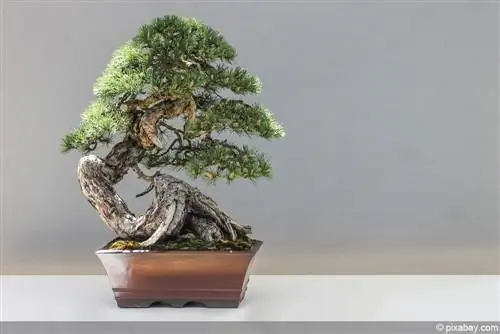
Many of the indoor bonsai species mentioned can be bought as cheap bonsai in supermarkets and garden centers. However, these plants often have severe scarring, ingrown wires, poor substrate or pots that are too small. If you want to have a really beautiful bonsai, you should spend a little more money and buy it from a specialist store. The investment is worth it.
Care
Although a bonsai has different care requirements than normal houseplants, it is not particularly difficult to keep it alive. However, because the small trees are planted in tiny bowls, they only have limited storage options for water and nutrients. Above all, this means that you have to water and fertilize them regularly. And a good location is also essential for the miniature tree.
Location
Tropical bonsai species prefer the brightest possible place by the window, which is somewhat shaded in summer when it is very hot. In general, the trees like it warm all year round, but in winter the temperatures should be slightly lower than in the growing season. A protected spot in the open air between mid-May and early September would be desirable. It is always necessary to find out in detail in advance about the special requirements of the individual indoor bonsai types. Most indoor bonsai require:
- Light requirement: as bright as possible
- shaded during the midday hours
- constant temperatures in summer: 20 to 25 degrees
- West or south window
Pouring
One of the most important elements in cultivating a bonsai tree is proper watering. How often you have to water depends on several factors:
- Type of tree
- Substrate mixture
- Size of the tree
- Size of bowl
- Season
- Location
Never water the tree routinely, but rather as soon as the substrate has dried (not completely dried out!). Do not water while the top layer of soil still feels moist. It is best to water in the morning or evening, always with room temperature, stale water. Because of the limited substrate volume, it is important to always soak the entire root ball very thoroughly.
Substrate/Repotting
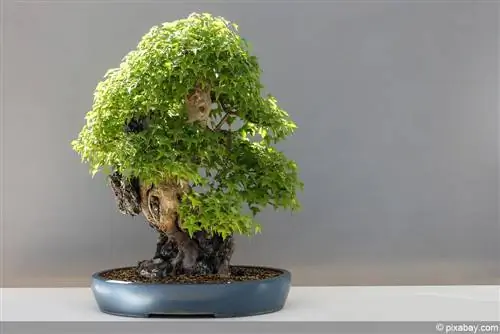
In order to prevent the roots from eventually taking over the entire bowl and the bonsai from starving, regular repotting is necessary. How often the tree needs to be repotted depends on what type of tree it is and how large the pot is. Young and fast-growing trees need to be repotted every two years at the latest, older or slow-growing plants only need to be repotted every third to fifth year.
- Time: early spring
- Substrate must be able to drain water well, but also store sufficient moisture
- some trees require a special substrate mix
- Mixture for most trees: 50% high-quality potting soil, 25% pumice gravel, 25% lava granules
- Add additional humus for better water storage
Wintering
In their original home, the trees can benefit from high temperatures, high humidity and good lighting conditions all year round. Therefore, there are a few things to consider when overwintering indoors so that the miniature tree survives the cold season he althy. The biggest problem is that in the winter months the light intensity in the apartment is usually significantly too low.
- place in a very bright location (even in full sun)
- alternatively set up a plant light (10 hours of light daily)
- do not overwinter over a warm radiator
- possibly place in a cooler bedroom or a guest room
- water a little less if the location is cool
- tropical indoor bonsai species warm all year round
- subtropical trees: slightly cooler (between 6 and 18 degrees depending on the plant type)
Conclusion
If you want to keep a bonsai as a purely indoor bonsai, it is important to choose the right type of tree. Only very few trees can tolerate warm temperatures all year round. For this reason, it is primarily the tropical trees that come into question here. If you follow the special care instructions and ensure a location with lots of light, especially in winter, then you will be successful with cultivation.

